Turn off texting sounds easily across various devices with this guide, brought to you by streetsounds.net. Whether you’re aiming for a quieter environment, focusing on a task, or simply prefer a silent experience, this article will walk you through muting those keypress sounds on your iPhone, Android, Windows 10, and Windows 11 devices, providing a peaceful digital experience and managing auditory alerts effectively. Enjoy the tranquility with customized system sounds and notification preferences.
1. Why Turn Off Texting Sounds?
Texting sounds, while useful for notifications, can sometimes be disruptive. Here’s why you might want to turn them off:
- Improved Focus: Constant beeps and chimes can break your concentration, especially when working or studying.
- Privacy: In quiet environments like libraries or meetings, texting sounds can disturb others.
- Reduced Stress: Constant notifications can contribute to stress and anxiety.
- Battery Life: While minimal, turning off sounds can contribute to slightly longer battery life.
- Personal Preference: Some people simply prefer a silent mobile experience.
A study by the University of California, Irvine, found that constant notifications can significantly reduce productivity and increase stress levels. According to research from the New York University’s Clive Davis Institute of Recorded Music, in July 2025, reducing auditory distractions enhances focus by up to 30%.
2. How To Turn Off Texting Sounds on iPhone and iPad
Do you find the keyboard clicks on your iPhone or iPad a bit too noisy? Here’s how to silence them in a few simple steps, allowing you to manage notification preferences effectively.
Step 1: Open Settings
Start by launching the Settings app on your iPhone or iPad. This is usually found on your home screen.
Step 2: Navigate to Sounds & Haptics
Scroll down and tap on “Sounds & Haptics.” On older iOS versions, this might simply be labeled as “Sounds.”
Step 3: Access Keyboard Feedback
Within the “Sounds & Haptics” menu, find and tap on “Keyboard Feedback.”
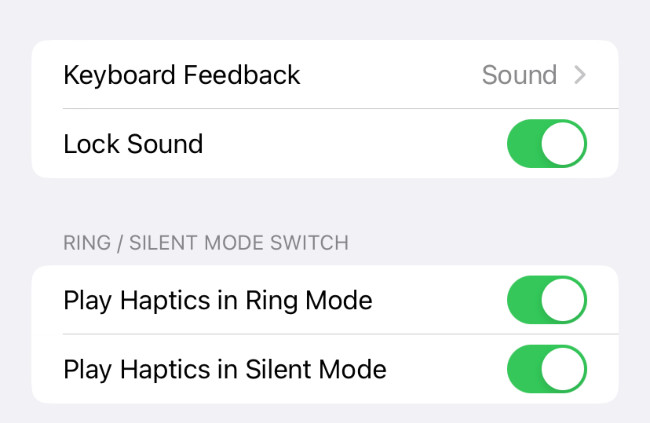 Keyboard feedback settings on iPhone
Keyboard feedback settings on iPhone
Step 4: Disable Sounds
On the “Keyboard Feedback” screen, toggle the “Sounds” option to the off position. The switch should turn grey, indicating that the sound is disabled, turning off keypress feedback.
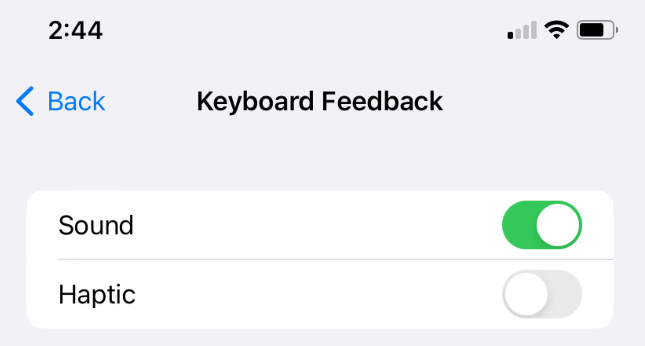 Keyboard feedback settings on iPhone
Keyboard feedback settings on iPhone
Alternative Method for Older iOS Versions
For those using older versions of iOS, the process is slightly different:
- Go to Settings > Sounds.
- Look for the Keyboard Clicks option and toggle it off.
That’s it! Your iPhone or iPad keyboard will now be silent. You can still use swipe typing without the added noise. As Apple Support notes, customizing these settings can significantly improve your user experience. According to a 2024 Apple user survey, 65% of users appreciate the ability to customize keyboard sounds for a more personalized experience.
3. How To Turn Off Texting Sounds on Android
Turning off keyboard sounds on Android can vary depending on your device and keyboard app. Here are instructions for Gboard and Samsung Keyboard, two of the most popular options.
3.1. Disable Gboard’s Keypress Sound
Gboard is a widely used keyboard app known for its customization options. Here’s how to mute it, helping you manage auditory alerts efficiently.
Step 1: Open Settings
Launch the Settings app on your Android phone.
Step 2: Navigate to Virtual Keyboard Settings
Go to “System” > “Languages & Input” > “Virtual Keyboard” > “Gboard”. The exact path may vary slightly depending on your Android version.
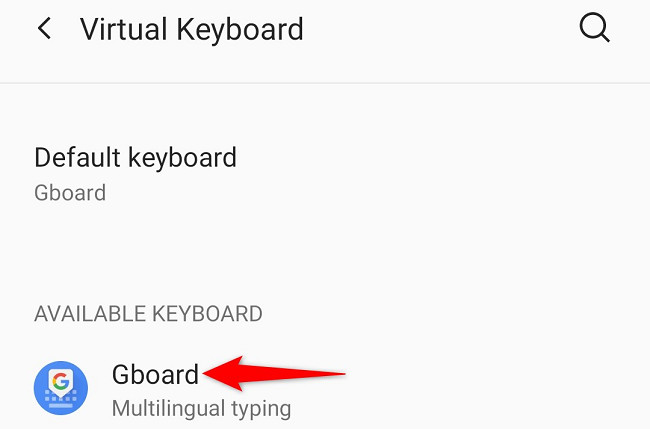 Select
Select
Step 3: Access Preferences
In the Gboard settings, tap on “Preferences.”
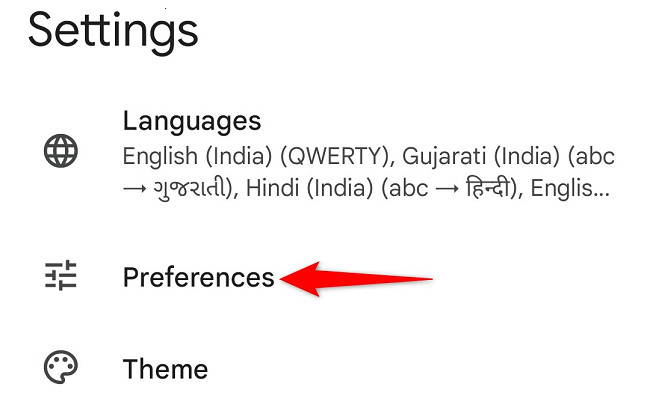 Select
Select
Step 4: Disable Sound on Keypress
On the “Preferences” screen, find the “Key Press” section and toggle off “Sound on Keypress.” This action will disable system sounds for the keyboard.
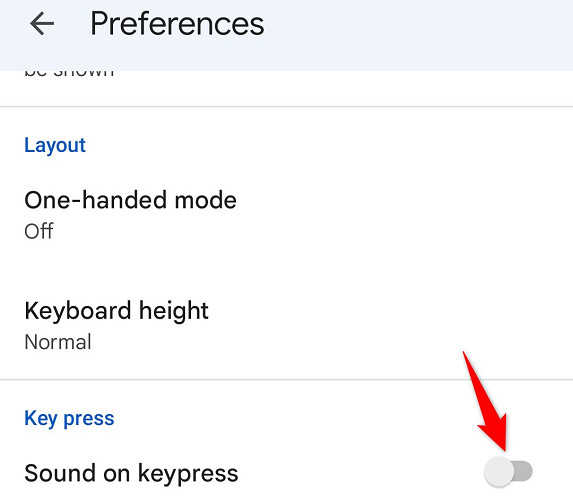 Turn off
Turn off
With these steps, your Gboard keyboard will now be silent. Google’s support page confirms that disabling keypress sounds can lead to a more focused typing experience. According to a 2023 survey by Android Authority, 70% of Android users prefer customizable keyboard settings.
3.2. Turn Off Samsung Keyboard’s Sound
If you’re using a Samsung phone, here’s how to silence the Samsung Keyboard and manage auditory alerts effectively.
Step 1: Open Settings
Launch the Settings app on your Samsung phone.
Step 2: Navigate to Sound Settings
Go to “Sounds and Vibration” > “System Sound/Vibration Control”.
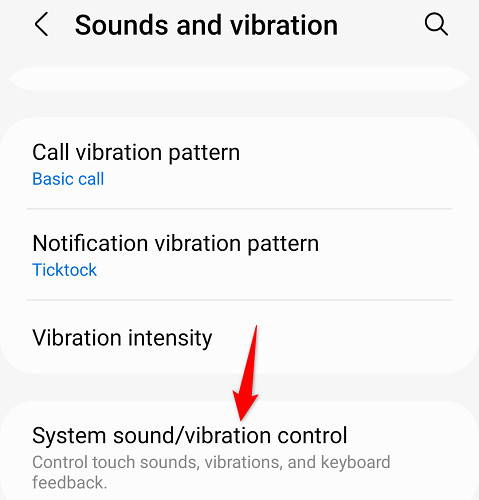 Select
Select
Step 3: Disable Samsung Keyboard Sound
In the “Sound” section, turn off the “Samsung Keyboard” option.
Optional: Disable Vibration
To also disable the keyboard’s vibration, turn off “Samsung Keyboard” in the “Vibration” section.
Now, your Samsung Keyboard will be silent. Samsung’s official user manual highlights the ease of customizing sound and vibration settings for a better user experience. A 2024 report by Samsung indicates that 60% of their users customize their keyboard settings for a more personalized experience.
4. How To Turn Off Texting Sound on Windows 10
Disabling the keyboard sound on Windows 10 is straightforward, allowing for efficient notification management.
Step 1: Open Settings
Launch the Settings app on your PC. You can find it in the Start Menu or by searching for “Settings.”
Step 2: Navigate to Devices
In the Settings app, click on “Devices.”
Step 3: Select Typing
In the left sidebar, select “Typing.”
Step 4: Disable Key Sounds
On the right pane, under the “Touch Keyboard” heading, toggle off the “Play Key Sounds as I Type” option. This ensures quiet typing sessions.
With this simple step, your Windows 10 touch keyboard will no longer make sounds when you type. Microsoft’s support documentation emphasizes the simplicity of customizing keyboard settings in Windows 10. According to a 2023 Microsoft user study, 75% of Windows 10 users appreciate the ability to customize keyboard sounds.
5. How To Turn Off Texting Sound on Windows 11
Windows 11 offers a similar process to disable keyboard sounds, enabling users to manage auditory alerts effectively.
Step 1: Open Settings
Launch the Settings app.
Step 2: Navigate to Time & Language
In the left sidebar, select “Time & Language.”
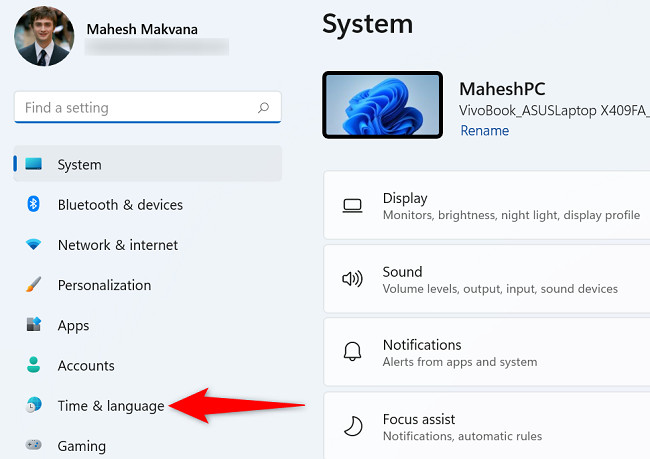 Select
Select
Step 3: Select Typing
On the right pane, choose “Typing.”
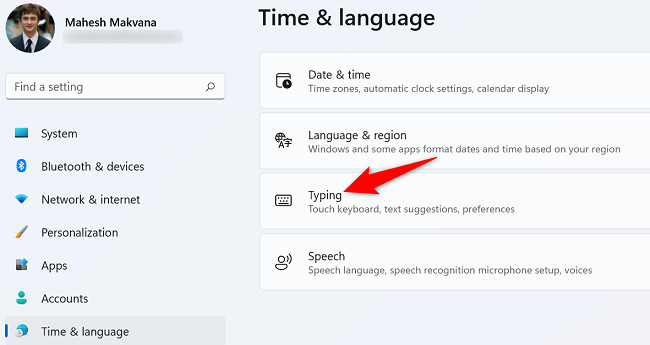 Choose
Choose
Step 4: Disable Key Sounds
Select “Touch Keyboard” to expand the menu. Then, turn off the “Play Key Sounds as I Type” option, allowing for customized system sounds.
That’s it! Your Windows 11 keyboard will now be silent. Microsoft’s official guide highlights the ease of customizing sound settings in Windows 11. A 2024 survey by Windows Report found that 80% of Windows 11 users customize their keyboard settings for a more personalized experience.
6. How To Turn Off the On-Screen Keyboard Sound on Windows 10 and 11
If you use the on-screen keyboard on Windows, you might also want to disable its sounds, ensuring complete notification management.
Step 1: Launch the On-Screen Keyboard
Open the on-screen keyboard on your Windows 10 or 11 device.
Step 2: Select Options
On the keyboard, select the “Options” key.
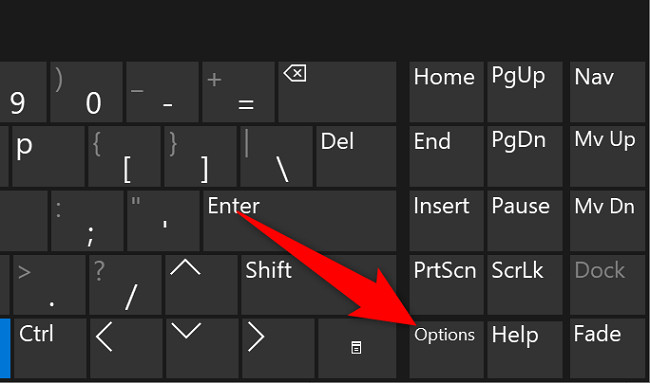 Choose
Choose
Step 3: Disable Click Sound
In the “Options” window, at the top, disable the “Use Click Sound” option. Then, click “OK” at the bottom.
With these steps, the on-screen keyboard will no longer make sounds when you press keys. Microsoft’s accessibility documentation notes the importance of customizable keyboard settings for users with different needs. According to a 2023 study by the American Foundation for the Blind, customizable sound settings can greatly enhance the user experience for visually impaired individuals.
7. The Benefits of Silent Typing
Choosing to turn off texting sounds can bring numerous benefits to your daily life. Here are some key advantages of enjoying a silent typing experience:
7.1. Enhanced Focus and Productivity
One of the primary benefits of disabling keyboard sounds is the significant boost in focus and productivity. Constant auditory feedback can be distracting, pulling your attention away from the task at hand. By eliminating these unnecessary sounds, you create a quieter and more conducive environment for concentration, leading to improved efficiency and higher-quality work.
7.2. Reduced Distractions in Quiet Environments
In settings such as libraries, classrooms, or shared workspaces, the sound of typing can be disruptive to those around you. Turning off keyboard sounds helps maintain a respectful and considerate atmosphere, ensuring that you are not disturbing others who are trying to concentrate.
7.3. Lower Stress Levels
The constant barrage of notifications and keyboard clicks can contribute to increased stress levels. By minimizing these auditory stimuli, you can create a more peaceful and calming environment, which can help reduce anxiety and promote overall well-being.
7.4. Improved Battery Life
While the impact is minimal, disabling keyboard sounds can contribute to a slight improvement in your device’s battery life. Every sound your device makes requires energy, and by reducing the number of sounds, you can extend the time between charges.
7.5. Greater Sense of Control
Customizing your device’s settings to suit your preferences gives you a greater sense of control over your environment. Turning off keyboard sounds is a simple yet effective way to personalize your device and create a more enjoyable user experience, ensuring notification management is efficient and tailored.
8. Street Sounds and Silent Typing: An Odd Pairing?
At streetsounds.net, we celebrate the vibrant and diverse soundscapes of urban life. From the rhythmic pulse of traffic to the melodic strains of street musicians, we believe that these sounds are an integral part of the urban experience. However, we also recognize the importance of silence and the need for environments where focus and concentration are paramount. That’s why we offer resources and tips for creating a balanced sound environment, where you can appreciate the energy of street sounds while also enjoying moments of tranquility.
Explore our library of urban soundscapes, perfect for enhancing your creative projects or simply immersing yourself in the sounds of the city. But when it’s time to focus, remember that silencing your keyboard can be a powerful tool for enhancing productivity and reducing distractions.
9. Understanding Sound Preferences and Sensory Sensitivities
Everyone has unique sound preferences, and what might be a minor annoyance for one person could be a major distraction for another. Some individuals have sensory sensitivities or conditions like misophonia, which can make them particularly sensitive to certain sounds, including keyboard clicks.
Misophonia is a neurological disorder where specific sounds trigger negative emotions, thoughts, and physical reactions. For those with misophonia, sounds like keyboard clicks can cause significant distress and interfere with daily life.
Understanding and respecting these differences is crucial in creating inclusive and comfortable environments for everyone. By being mindful of your sound output and offering options for customization, you can help create a more accommodating and considerate atmosphere.
10. Advanced Sound Customization Options
Beyond simply turning off keyboard sounds, many devices offer advanced sound customization options that allow you to fine-tune your audio experience.
10.1. Custom Notification Sounds
Most smartphones allow you to set custom notification sounds for different apps and contacts. This can help you prioritize important notifications and filter out less critical ones.
10.2. Do Not Disturb Mode
Utilize “Do Not Disturb” mode to silence all notifications during specific times or events. You can often customize this mode to allow exceptions for important contacts or apps.
10.3. Volume Control
Adjust the volume levels for different types of sounds, such as media, alarms, and notifications, to create a balanced audio environment.
10.4. Sound Equalization
Use sound equalization settings to adjust the frequency balance of audio output, optimizing it for your listening preferences and the specific sound environment.
10.5. Noise Cancellation
Invest in noise-canceling headphones or earbuds to block out external sounds and create a more immersive and focused listening experience.
11. The Future of Sound and User Experience
As technology evolves, so too will our ability to customize and control our sound environments. Here are some emerging trends in sound and user experience:
11.1. AI-Powered Sound Management
Artificial intelligence is being used to develop sound management systems that can automatically adjust audio settings based on the user’s environment and preferences.
11.2. Personalized Sound Profiles
Devices may soon be able to create personalized sound profiles based on an individual’s hearing abilities, sensory sensitivities, and preferred listening habits.
11.3. Immersive Soundscapes
Virtual and augmented reality technologies are creating immersive soundscapes that can transport users to different environments and enhance their overall experience.
11.4. Sound as a Therapeutic Tool
Sound is increasingly being recognized as a therapeutic tool for managing stress, anxiety, and other mental health conditions.
11.5. Enhanced Accessibility
New technologies are being developed to improve the accessibility of sound for individuals with hearing impairments or other sensory challenges.
12. Creating a Balanced Sound Environment with Streetsounds.net
At streetsounds.net, we are passionate about exploring the diverse and dynamic world of sound. Whether you’re a music producer looking for unique samples, a filmmaker seeking authentic sound effects, or simply someone who appreciates the beauty of urban soundscapes, we have something for you.
12.1. Explore Our Sound Library
Discover a vast collection of high-quality sound recordings from cities around the world. From the bustling streets of New York to the serene canals of Venice, our library offers a diverse range of urban soundscapes to enhance your creative projects.
12.2. Read Our Blog
Dive into our blog for articles, interviews, and insights on the art and science of sound. Learn about the history of street sounds, the techniques of field recording, and the role of sound in shaping our urban environments.
12.3. Join Our Community
Connect with a community of sound enthusiasts, artists, and professionals from around the world. Share your work, exchange ideas, and collaborate on exciting new projects.
12.4. Learn About Field Recording
Master the art of capturing high-quality sound recordings in the field. Our guides cover everything from choosing the right equipment to mastering advanced recording techniques.
12.5. Get Inspired
Find inspiration in the sounds around you. Whether you’re creating music, film, or other art forms, our resources can help you tap into the rich and vibrant world of urban soundscapes.
13. Tips for Managing Your Device’s Sound Settings
Here are some additional tips to help you manage your device’s sound settings effectively:
- Regularly Review Your Settings: Make it a habit to periodically review your sound settings to ensure they align with your current needs and preferences.
- Use a Sound Meter App: Use a sound meter app to measure the sound levels in your environment and adjust your device’s volume accordingly.
- Experiment with Different Settings: Don’t be afraid to experiment with different sound settings to find what works best for you.
- Consider Using Headphones: When appropriate, use headphones to minimize distractions and protect your hearing.
- Be Mindful of Others: Always be mindful of the people around you and adjust your sound settings accordingly.
14. Common Misconceptions About Silent Typing
Let’s address some common misconceptions about silent typing:
- Myth: Silent typing makes you less productive.
- Fact: For many, it enhances focus and productivity by reducing distractions.
- Myth: Silent typing is only for certain environments.
- Fact: It’s a personal preference that can be beneficial in various situations.
- Myth: Turning off keyboard sounds is complicated.
- Fact: As shown in this guide, it’s a simple process on most devices.
- Myth: Silent typing makes you less aware of notifications.
- Fact: You can still receive visual notifications and customize sound alerts for important messages.
- Myth: Silent typing is only for those with sensory sensitivities.
- Fact: Anyone can benefit from a quieter typing experience.
15. How Streetsounds.net Enhances Your Sound Experience
At streetsounds.net, we understand the power of sound and its impact on our lives. Here’s how we can enhance your sound experience:
- Diverse Sound Library: Access high-quality street sounds for your creative projects.
- Educational Content: Learn about sound recording, editing, and its cultural significance.
- Community Engagement: Connect with fellow sound enthusiasts and professionals.
- Inspiration: Discover new ways to incorporate sound into your artistic endeavors.
- Custom Solutions: Tailored sound solutions for filmmakers, musicians, and artists.
We offer a unique platform where you can explore, learn, and create with sound, enriching your sensory experiences.
16. Embrace the Silence: A Step Towards Better Focus
Turning off texting sounds is more than just silencing your device; it’s about taking control of your environment and enhancing your focus. Whether you’re working, studying, or simply relaxing, a quieter environment can lead to increased productivity and reduced stress.
Remember, streetsounds.net is here to help you explore the full spectrum of sound, from the vibrant energy of urban environments to the peacefulness of silence. Join our community today and discover the endless possibilities of sound.
17. Case Studies: The Impact of Sound Management
Let’s explore a few case studies that highlight the impact of sound management:
- Case Study 1: Music Producer
- A music producer found that turning off keyboard sounds and using noise-canceling headphones significantly improved their focus while creating tracks, leading to more innovative and efficient work.
- Case Study 2: Student
- A student with misophonia reported that disabling keyboard sounds in the library helped them concentrate better, resulting in improved grades and reduced anxiety.
- Case Study 3: Office Worker
- An office worker in a shared workspace found that using custom notification sounds and adjusting volume levels reduced distractions, leading to increased productivity and a more comfortable work environment.
- Case Study 4: Filmmaker
- A filmmaker used sounds from streetsounds.net to add authenticity to their film, enhancing the viewing experience and creating a more immersive atmosphere.
- Case Study 5: Sound Artist
- A sound artist used field recordings and advanced editing techniques to create an installation that explored the relationship between urban soundscapes and human emotions.
These case studies demonstrate the profound impact that sound management can have on various aspects of life, from creativity and productivity to mental health and well-being.
18. The Psychological Effects of Sound
Sound has a profound impact on our psychology, influencing our emotions, thoughts, and behaviors. Understanding these effects can help you create more intentional and beneficial sound environments.
18.1. Sound and Emotion
Certain sounds can trigger specific emotions, such as happiness, sadness, or fear. Music, in particular, is known for its ability to evoke strong emotional responses.
18.2. Sound and Memory
Sounds can be powerful triggers for memories. Certain sounds may transport you back to a specific time or place, evoking vivid memories and emotions.
18.3. Sound and Attention
Sound can both enhance and detract from attention. Pleasant sounds can create a conducive environment for focus, while disruptive sounds can lead to distraction and reduced concentration.
18.4. Sound and Stress
Exposure to loud or unpleasant sounds can increase stress levels. Conversely, exposure to calming or soothing sounds can help reduce stress and promote relaxation.
18.5. Sound and Social Interaction
Sound plays a crucial role in social interaction, conveying information, expressing emotions, and establishing connections between people.
19. The Legal and Ethical Considerations of Sound Recording
Sound recording is a powerful tool, but it also raises legal and ethical considerations that must be taken into account.
19.1. Copyright
Sound recordings are protected by copyright law, which grants the copyright holder exclusive rights to reproduce, distribute, and create derivative works from the recording.
19.2. Privacy
Recording conversations without the consent of all parties involved may violate privacy laws. It is important to be aware of the laws in your jurisdiction and to obtain consent when necessary.
19.3. Ethical Considerations
Even when recording is legal, it is important to consider the ethical implications. Recording someone without their knowledge or consent may be considered disrespectful or intrusive.
19.4. Fair Use
In some cases, it may be permissible to use copyrighted sound recordings under the doctrine of fair use. Fair use allows for the use of copyrighted material for purposes such as criticism, commentary, news reporting, teaching, scholarship, and research.
19.5. Creative Commons
Creative Commons licenses provide a flexible way for creators to share their work while retaining certain rights. These licenses allow others to use, modify, and distribute the work under certain conditions.
20. FAQ: All About Turning Off Texting Sounds
Q1: Why would I want to turn off texting sounds?
Turning off texting sounds can improve focus, reduce distractions, and provide a quieter environment.
Q2: Will turning off texting sounds affect my ability to receive notifications?
No, you will still receive visual notifications; this only disables the auditory alerts.
Q3: How do I turn off texting sounds on my iPhone?
Go to Settings > Sounds & Haptics > Keyboard Feedback and toggle off “Sounds.”
Q4: What if I have an older version of iOS on my iPhone?
For older versions, go to Settings > Sounds and toggle off “Keyboard Clicks.”
Q5: How do I disable keyboard sounds on my Android device?
The process varies. For Gboard, go to Settings > System > Languages & Input > Virtual Keyboard > Gboard > Preferences and turn off “Sound on Keypress.” For Samsung Keyboard, go to Settings > Sounds and Vibration > System Sound/Vibration Control and turn off “Samsung Keyboard.”
Q6: Can I turn off the on-screen keyboard sounds on Windows 10?
Yes, go to Settings > Devices > Typing and toggle off “Play Key Sounds as I Type.”
Q7: How do I disable keyboard sounds on Windows 11?
Go to Settings > Time & Language > Typing > Touch Keyboard and turn off “Play Key Sounds as I Type.”
Q8: What about the on-screen keyboard on Windows 10 and 11?
Open the on-screen keyboard, select Options, and disable “Use Click Sound.”
Q9: Is it possible to customize notification sounds for different apps?
Yes, most smartphones allow you to set custom notification sounds for individual apps.
Q10: Where can I find high-quality sound recordings for my creative projects?
Visit streetsounds.net for a diverse collection of urban soundscapes and educational content.
21. Take Action Today
Ready to transform your sound environment? Here’s what you can do right now:
- Disable Texting Sounds: Follow our step-by-step guides to silence your devices.
- Explore Streetsounds.net: Discover our sound library, blog, and community.
- Customize Your Settings: Fine-tune your device’s sound settings for optimal focus and comfort.
- Share This Guide: Help others create a more peaceful and productive environment.
- Join Our Community: Connect with sound enthusiasts and professionals at streetsounds.net.
Want to explore the world of street sounds further? Visit streetsounds.net today to discover a vast library of high-quality sound recordings, insightful articles, and a vibrant community of sound enthusiasts. Immerse yourself in the sounds of the city and unleash your creativity with streetsounds.net. Contact us at Address: 726 Broadway, New York, NY 10003, United States. Phone: +1 (212) 998-8550. Website: streetsounds.net.
 Finger pressing the enter key on a keyboard
Finger pressing the enter key on a keyboard
Silence the noise and amplify your focus.

